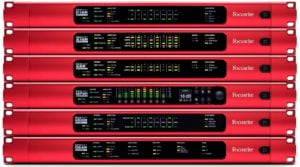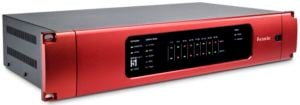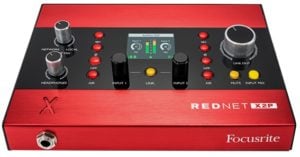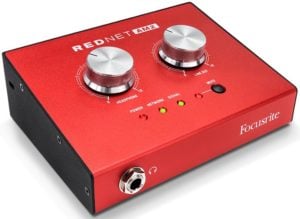Transferring audio from one place to another is easy—until the question comes up of how to get lots of audio over a long distance, and do so reliably. For pro audio, Audio over Internet Protocol (AoIP Definition:
Definition:
AoIP (Audio over Internet Protocol): How audio is sent over a network, such as the internet or Ethernet.) is the solution for distributing audio in stadiums, large houses of worship, multiple studios, broadcast, and the like. AoIP systems have the potential for high audio quality; they can run at a high bit rate Definition:
Definition:
The number of bits (pieces of data) that passes per second, usually Mbit/s., with low latency Definition:
Definition:
The amount of delay a signal, data, sound, video, or control signal acquires within a device, system, or long-distance connection. and no audio compression Definition:
Definition:
1. Reducing the dynamic range of an audio or video signal for consistency, to keep it from exceeding the available headroom, or providing a special effect. 2. With data, using a process to reduce the amount of data. Compression can be lossless, where decompressing replicates the original signal, or lossy, where compression occurs by judging some data as unnecessary, and can therefore be discarded from the file.. However, whether that potential is realized depends on the AoIP protocol itself, and the system hardware.
Another consideration is redundancy, because for any kind of broadcasting or live sound work, reliability isn’t just desirable—it’s essential. Ease of collaboration and data-sharing is also an important AoIP attribute. For film scoring, where multiple studios and teams are often in play, networking promotes a collaborative workflow and shared resources. Professional recording is another field where not everything you want to work with is in the same place at the same time. The grand piano or drums might be recorded in Studio A, while the mix into which these will be incorporated is being fleshed out in a post room. In today’s big studios, there are more rooms, more people, and more potential congestion in getting audio from one place to another.
Although there are numerous technological advantages to AoIP, there’s also the “neatness” factor. In particular, public venues like houses of worship, conference rooms, hotels, and airports don’t want miles of copper cable running around. The svelte nature of Ethernet Definition:
Definition:
A local area network (LAN) using cables classified according to certain categories (CAT5, CAT6, CAT5e, etc.). These relate to the speed a cable can handle. cables, and their ability to be hidden easily, is a huge advantage under these circumstances.
For audio networking, Dante is a popular, mature protocol (see the related article, What is Dante Audio Networking: A Basic Overview). As to the hardware—that’s where Focusrite comes in.
The company has established a stellar reputation in the world of pro audio, specifically with preamps and interfaces. With RedNet, they’ve combined that hardware experience with the Dante AoIP protocol.
The Big Picture
Zooming out a bit, all of Focusrite’s Dante-friendly Red gear works over the Layer 3 protocol of network communications. This is the so-called network layer that handles all the “busy work” of addressing and routing, so any data Definition:
Definition:
Information used by a computer in order to arrive at a decision. Although this is a plural term, it's often treated in the singular. being transferred only needs to know its source and destination—the network layer itself is smart enough to get the data where it needs to go. Compared to Layer 2, which is subject to congestion, Layer 3 can grow to handle a system’s needs while retaining efficiency. Most of the infrastructure for buildings where you’d need a RedNet system already include Layer 3 networking, because businesses prioritize both a need for control and the ability to handle growth, which is where Layer 3 excels.
The issue that Focusrite’s line of RedNet gear addresses is that your mic pres, audio interfaces, and converters are inherently incompatible with Ethernet. Several companies provide adapters to link existing, non-Dante gear to Dante networks, but Focusrite designs Dante into the Red product line from the ground up (some of them also include Power-over-Ethernet, aka PoE—these have no need for power supplies or AC adapters).
It’s also important to understand that RedNet is modular. Just as you can add hard drives, audio interfaces, and the like to a computer, you can add modules to a Dante/RedNet system. Need a headphone amp Definition:
Definition:
Abbreviation for either Ampere or Amplifier. somewhere? Sure. Do you have teams working in Studio A and Studio B who not only need to exchange files, but pass along audio being sent into Studio B’s interface to Studio A? No problem; simply add another interface to the system.
The Audio Interfaces
Focusrite’s three Red audio interfaces look similar; their main differences are on the back panel. While they have the Thunderbolt Definition:
Definition:
A computer interface port or cable that multiplexes PCIe and DisplayPort data lines into two serial signals (along with DC power), which is then demultiplexed into separate PCIe and DisplayPort ports by the Thunderbolt controllers at receiving devices. ports you expect to see on a high-quality audio interface Definition:
Definition:
A device to convert audio signals into digital code suitable for use by a computer; typically communication occurs through a port such as USB, Thunderbolt, FireWire, etc. , they add Ethernet connectors to provide 32 x 32 Dante I/O Definition:
Definition:
(Input/Output): 1. A pair of connections that provide input(s) and output(s). 2. The connections that link a computer to devices outside the computer.. For example, one of the most common Dante applications is adding more mics to a system. The Red 8Pre’s front panel looks familiar (Fig. 1), with I/O selection, metering, headphone outs, and even a couple instrument inputs.

Turn around to the back panel, though, and in addition to Dante you have eight mic pre inputs on a DB-25 Definition:
Definition:
1. With audio, a standard 25-pin connector for multi-conductor cables intended to carry multiple channels of audio. 2. With computers, a standard 25-pin connector used in cabling between RS-232 ports. connector, 16 analog Definition:
Definition:
A signal that is continuous in nature, as opposed to being defined as a series of discrete numbers (or elements) as found in digital signals; electrically "analogous" to an acoustical signal in the air. line ins and outs on DB-25 connectors, a pair of ADAT Definition:
Definition:
ADAT (Alesis Digital Audio Tape): An S-VHS-based, 8-track digital audio recording format, syncable with additional units to add tracks in groups of 8. optical connectors, S/PDIF Definition:
Definition:
(Sony/Philips Digital Interconnect Format) A protocol for a stereo digital audio connection, based on AES3, that uses coaxial cable or TOSlink optical cables., dual Thunderbolt 2 ports, dual Mini DigiLink ports, word clock Definition:
Definition:
A series of regular, highly accurate timing pulses equal to a digital system's sample rate, which provides a timing signal for interconnected digital equipment. It may be a separate device (e.g., clock generator) or embedded in a digital stream. Typically uses a BNC connector. I/O, loop Definition:
Definition:
1. To re-record dialog over video. See ADR. 2. To replay a portion of audio or video content. 3. (sampling) To repeat a section of a waveform so that it can sustain indefinitely. 3. To repeat a phrase or section of sound multiple times within a composition or recording. sync Definition:
Definition:
To make two or more pieces of equipment or signals synchronize with each other., and two analog monitor outputs to go to your control room.
Focusrite’s emphasis on DB-25 connectors makes sense. In addition to being wired to existing standards, they simplify cabling but also, save enough space that most RedNet modules fit in a single rack Definition:
Definition:
A frame for holding gear that meets an industry standard for enclosures. This specifies a 19 inch width, and a height that is some multiple of 1.75 inches. A rack frame can be open or enclosed, and has rails drilled with standardized screw holes for attaching rack equipment.. space. However some situations require a simpler solution, with XLR connectors so you can just plug Definition:
Definition:
A connector, normally male and attached to a cable. in mics and go. For this, the lower-priced Red 4Pre has four mic ins on XLR connectors, and halves the analog line I/O to 8 channels.
Focusrite’s mic pres have always had a superb reputation. However, they too are part of RedNet because they can be controlled remotely (enable highpass filter, choose phantom power Definition:
Definition:
A source of power for a microphone (usually condenser) that travels to the microphone over the microphone's cable. There are different voltage standards and requirements for different microphones, but the most common standard is 48 Volts. It derives its name because there is no visible power cable. for individual mics, set gain, recall settings, and the like) over Thunderbolt using the RedNet Control software. In addition to mic preamp control, this software handles mapping physical I/O to drivers and Pro Tools|HD channels, monitoring, and “virtual patching” for external hardware inserts. Another advantage of all three interfaces is that because they include both DigiLink and Thunderbolt, they can switch between Pro Tools and another DAW Definition:
Definition:
DAW (Digital Audio Workstation): A computer program or stand-alone device that provides digital audio recording, editing, and mixing. that’s hooked into the Thunderbolt interface.
There’s even an option for Thunderbolt 3-based, cutting-edge Pro Tools studios. The Red 16Line is similar to the Red 8Pre, but handles mics via two XLR mic inputs (Fig. 2).

The full set of analog specs are on Focusrite’s website; suffice it to say they’re impressive. In terms of digital Definition:
Definition:
A signal or data expressed as series of the digits 0 and 1, typically represented by values of a physical quantity such as voltage or magnetic polarization. specs, accommodated sample rates are 44.1, 48, 88.2, 96, 176.4, and 192 kHz Definition:
Definition:
kHz (Kilohertz): 1,000 Hertz, or one thousand cycles per second., all with 24-bit resolution Definition:
Definition:
1. (video) The measure of pixels horizontally and vertically. For example, 1920x1080 is considered HD, or high-definition. 2. (audio) The combined bit depth and sample rate of a digital audio signal..
Expansion: The World of Audio over IP
If you add up the rear-panel I/O, it doesn’t equal the 64 x 64 channel Definition:
Definition:
1. In radio, television, citizen's band radio, and other wireless communications modes, a specific frequency for communication. 2. In mixers and video, an input or output signal path with controls. 3. In MIDI, one of 16 data paths. count quoted for the Red 16Line or the Red 8Pre, or the 58 x 64 spec for the Red 4Pre. That’s because the additional I/O can come from anywhere else in a RedNet system, and while the interfaces are cool, Audio over IP Definition:
Definition:
1. IP (Internet Protocol): A digital data standard over Ethernet. 2. IP (Ingress Protection): A rating of an electrical device, such as a lighting fixture, regarding protection from foreign objects or water. 3. IP (Intellectual Property): Refers to creations of the mind, such as inventions; literary and artistic works; designs; and symbols, names and images used in commerce. Intellectual Property is protected in law by, for example, patents, copyright and trademarks, etc. is what gives RedNet its power because of the variety of signals you can interface (Fig. 3).

For example, suppose you need to make multiple AES/EBU Definition:
Definition:
AES/EBU (Audio Engineering Society/European Broadcasting Union): A 2-channel digital audio format created by the AES and EBU that uses XLR connectors, and is similar to the S/PDIF digital audio format. (AES3 Definition:
Definition:
A 2-Channel digital audio format with clocking up to 384 kHz.) digital ins and outs part of RedNet. The RedNet D16R is a 16 x 16 AES3 interface, with DB-25 connectors wired to the AES59 spec. It includes a feature that underscores RedNet’s professional nature—redundancy for both the network and power supply Definition:
Definition:
A device (internal or external to another device) that provides power for active circuitry. Can be AC, DC or battery-powered.. With a Focusrite USB Definition:
Definition:
(Universal Serial Bus) A standard, bi-directional serial connection between computers and peripheral devices. interface in a home studio Definition:
Definition:
A recording studio located in a residence that may be dedicated to a hobby, or to commercial projects. See Project Studio., tripping over the power cable and losing the interface momentarily may be inconvenient, but it’s not a deal-breaker. With commercial applications, any loss of signal or power can be a disaster. Nor can you afford to spend too much time sorting things out, so features like sample rate conversion Definition:
Definition:
Converting a digital audio or video signal from one sample rate to another, usually to ensure compatibility or save memory. on all inputs assist with the promise of “plug and play.”
Other units cover analog I/O; the RedNet A16R provides 16 channels of line-level audio I/O (using DB-25 connectors), and one set of AES/EBU I/O. For smaller applications, the RedNet A8R does the same with 8 channels. For extra functionality, the RedNet MP8R hooks 8 Focusrite preamps into Dante networks. Whether you need extra mics for the drum set being recorded in Studio A, or to handle a panel discussion in a conferencing setup, this solves a lot of problems. As with other RedNet units, there are quite a few extra features—like automatic gain compensation Definition:
Definition:
A link between a FOH (Front of House) and Monitor Mixer where if one mixer changes the input gain trim, the other console makes an equal and opposite adjustment to keep its mix level independent from the shared preamp. for a second set of transmitters to simplify live broadcast and live sound work, “hooks” for Yamaha CL and QL consoles to control gain and other parameters, pad, phase control, highpass filter, and remote Definition:
Definition:
A broadcast from the field, not from the studio. A Remote Control. signal metering.
Additional Audio-over-IP devices include the RedNet HD32R, with 32 x 23 I/O for Pro Tools | HD-based systems (HDX, HD Native, HD Native Thunderbolt, HD TDM Definition:
Definition:
(Time Division Multiplexing) A method of communicating multiple signals in a common data stream.). Rear-panel I/O is Dante, primary and expansion DigiLink connections, word clock, and loop sync. One of the most important features is that you can cascade Definition:
Definition:
To link multiple devices, such as mixers or switchers, to create a larger system. up to six HD32R units in a Pro Tools | HDX system to accommodate 192 inputs and outputs (the maximum Pro Tools HDX can handle). You can also cascade up to three units for Pro Tools | HD.
RedNet handles MADI Definition:
Definition:
MADI (Multichannel Audio Digital Interface): Originally called AES10. A unidirectional (sender to receiver), digital audio interface that has common features with the AES3 stereo digital audio interface. MADI transmits up to 64 channels serially over fiber-optic or coaxial lines. as well with the RedNet D64R, which features 64 x 64 MADI optical and coax I/O. Like the previous units, this has network and power supply redundancy.

The original RedNet line includes units like the RedNet-5 (32 x 32 bridge interface for Pro Tools | HD). Its functionality is similar to the HD32R; it’s less expensive, but takes 2 rack spaces (Fig. 4), and lacks the network and power supply redundancy of newer units. RedNet-1, another RedNet module housed in a 2U rack unit, is the simplest multichannel Dante option: eight channels of line-level, analog I/O.
Let’s Get Small
Not all RedNet components are as deep—two “tabletop” units round out the line. The RedNet X2P (Fig. 5) is a basic 2 x 2 analog interface for Dante, with stereo Definition:
Definition:
A two channel signal simulating a sound space, typically played through two speakers. XLR output jacks, and stereo XLR “combo” jacks for the inputs (these accommodate 1/4" instrument inputs as well as XLR mic and line). There’s also a convenient, front-panel headphone jack.

Of course, it boasts Focusrite mic pres, with phantom power, polarity Definition:
Definition:
1. In electricity, the quality that indicates whether the pole of a direct current device like a battery has more electrons than the other (negative polarity) or fewer electrons than the other (positive polarity), which relates to the direction of current flow. 2. In audio, a reference to whether a point in a signal is above or below the zero voltage line (positive or negative, respectively). Reversing polarity "flips" a signal so that if a point in its waveform was positive, that point will be negative instead. Often confused with phase. See Phase. switch, high-pass filter Definition:
Definition:
A circuit or sometimes, mechanical device that passes audio above a specific frequency, and attenuates audio below that frequency. A typical audio application is reducing frequency response below 50-200 Hz to minimize hum, room noise, plosives, and bass reflection build-ups due to acoustical issues. , and Focusrite’s proprietary “air” control (this is featured in the above units as well, and emulates the sound of Focusrite’s transformer-based mic preamps used in vintage gear). Because the X2P is power-over-ethernet, there’s no need for an AC adapter—the Dante connection provides power as well as clocking Definition:
Definition:
The process of generating a master or common clock to which digital audio systems can synchronize., data, and remote control. Meanwhile, the RedNet AM2 (Fig. 6) is the “I need a monitor output, now” unit with stereo analog outs, a headphone amp, and power-over-ethernet.

Finally, the RedNet PCIeR is a PCIe card that brings 128 x 128 I/O over Dante to Windows and Mac. Compatible Definition:
Definition:
Capable of operating with a particular selection of hardware or software. with ASIO Definition:
Definition:
ASIO (Audio Stream Input/Output): A computer driver developed by German software company Steinberg to link hardware inputs and outputs with audio-based recording and playback programs. Used primarily with Windows operating systems. and Core Audio, it provides network redundancy, low latency, and works with Thunderbolt expansion chassis for computers that don’t have slots (Fig. 7).

It’s a Networked World...
Ultimately, so much of today’s world is about networks—anyone who’s used the internet knows that. It’s even worked itself into the vernacular, where people talk about “networking” with each other. Think of how many homes have home networks, and use routers and wi-fi Definition:
Definition:
A wireless network protocol for device networking and internet access. Also spelled WiFi, wifi, or Wifi. extenders. It’s still a wired world, but also consider that the cost of copper wire has gone through the roof—the solutions that worked at the turn of the century are fading. Meanwhile, Ethernet has risen to a position of prominence that won’t be going away any time soon.
These kinds of networks will become only more prevalent in the years ahead. If you’re upgrading or installing a new system for commercial sound work, it’s crucial to take a look at networked audio and what it can deliver not just now, but in the future. Finally—the technology is proven, has become more affordable, and prioritizes reliability. It seemed like only yesterday that the Audio Engineering Society convention was abuzz with white papers about how networked audio was going to take over in the future... well, tomorrow is here.















